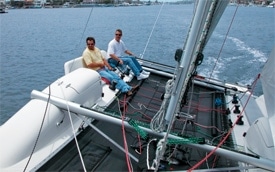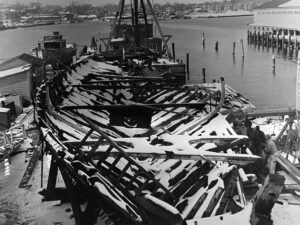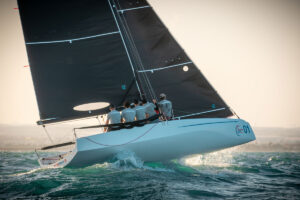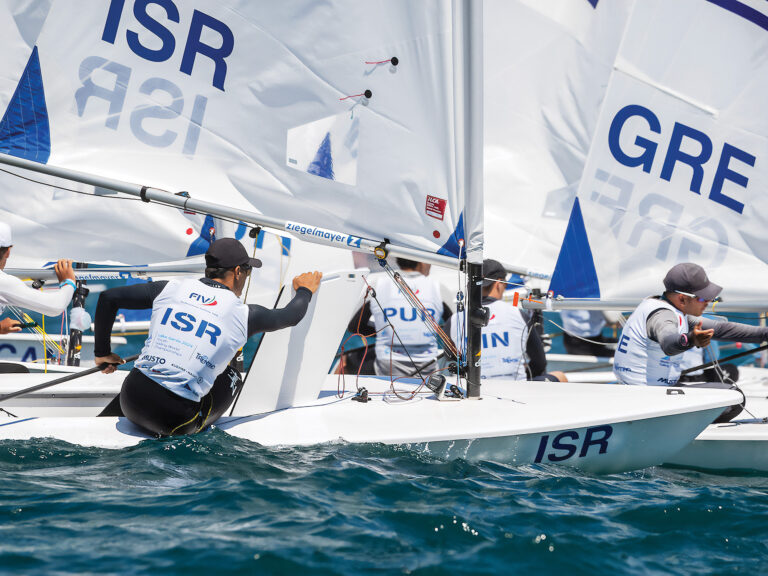
Reynolds 33 Review
You could say the Reynolds 33 is a multihull version of the recent trend in fast, classy monohull daysailers. Only it’s a whole lot faster, and it has a range of gears that allows you to easily shift between racing and cruising modes. You can sail the 33 with a full or reefed main, and use headsails of progressively greater area-from jib, to blast jib, to screacher, to spinnaker. Working with Morrelli & Melvin Design, Randy Reynolds spent a couple of years on prototypes, finally settling on a powerful 48-foot aluminum rig and a 14-foot beam that fits in a slip. Reynolds likes to call his creation “just another cruising boat,” but with tongue somewhat planted in cheek. Yes, it can sleep four sailors in single berths, but speed is what makes this former windsurfing sailmaker’s blood move. When he recruited the likes of Charlie Ogletree, Johnny Lovell, Howard Hamlin, and Pete Melvin to race separate boats in last spring’s overnighter to Ensenada, they didn’t cross the finish line talking about the accommodations. Reynolds beat them all, but it sounds as if they’ll be back. Ogletree, who has become a dealer, says he’s done 24.5 knots under blast jib and full main, “It is like sailing my A-Cat…the boat is a Ferrari with seating for all your friends.” For my sail with Reynolds last May, we sailed out of Newport Harbor, Calif., in light air. After raising the square-top mainsail and unrolling the 133-percent high-clewed “blast” jib, a light breeze quickly pushed us out past the breakwaters and into the ocean. There we turned north on port tack and unrolled the biggest jib, a 600-square-foot screacher, mounted on a Harken furler on the tip of the sprit. Sailing in 5 to 7 knots of wind and without fuss or any water on deck, the boat began averaging 10 to 12 knots. There we were, a mile off the beach on an oily swell with one of those tantalizing breezes in which many monohull fleets swelter under a postponement flag-and we were clicking off the miles, often flying a hull. Reynolds reminded me several times how much sail we had up (nearly 1,200 sq. ft.) and pointed out whether I was above or below a beam reach-important because you need to know which way to turn to bleed power if you catch a puff and your windward hull really starts to fly. The boat sometimes felt a bit light under me, and Reynolds occasionally encouraged me to head up a little, but most of the time the boat just felt good and really fast. As the wind freshened to 8 knots, we cracked off a little and maxed the GPS at one point at 14.7 knots. That’s when I began to wonder how it would feel at 16 or 18. After we got up near the Huntington Beach pier (about 8 miles north), we rolled the screacher and shifted into cruise mode to eat our sandwiches, idling along at about 7 knots under main alone. While we ate, Reynolds described his experience capsizing a 33 some months earlier, explaining how, with one powerboat to assist, they’d been able to right the boat within an hour, with no damage. He didn’t make light of the capsize, but emphasized his efforts to make a capsize a “non-event.” In later phone conversations, he said he’s experimenting with buoyant hiking racks that should help prevent capsizes and said he’d publish information on them at www.r33.com-where his detailed capsize-recovery account can also be found. With 18 boats built, Reynolds said he knows of three capsizes, but only by racing sailors who were pushing hard. Most owners, he says, will likely sail in a cruising mode, keeping both hulls in the water and skating along faster than windspeed, although not approaching twice windspeed. One key to staying upright is to make it easy to reduce sail quickly, and the roller-reefing (around the boom) mainsail and furling headsails accomplish that. As long as the boom topping lift is marked so you can make sure the boom is close to horizontal before you get started, the main will roll easily; Reynolds has also added a second topping lift so there’s always one to windward of the big mainsail roach that is easy to tension. While I steered, he and R33 dealer John Papa rolled a quick reef into the main in 45 seconds, start to finish. Heading south again, we set the nearly 1,300-sq. ft. chute for a while, and despite only 5 knots of breeze, I could heat it up and average 8 or 9 knots, or sail it deeper-as if heading for a leeward mark-and make 7 knots. Reynolds said that the last nine 33s he’s built have had 14 feet of beam, which proves to be faster downwind than the 16-foot beam versions he built earlier. Upwind, the narrower boat is also faster in light wind because it flies a hull sooner, but it gives away a little in full-power conditions. The 33 has lots of details to study, several of which are visible in the photos. The odd-looking pair of “wings” are really a combination lifeline, backrest, and spray shield, and are extremely comfortable. The middle of the three athwartships beams sits on top of the blister cabins, so the mast is stepped well above the level of the full-length trampoline and the dolphin striker that supports the mast will never get near a fish or a wave. While this adds clutter and a hurdle for the crew, it creates a secure working space with plenty to hold onto. It also offers a good mounting position for the jib tracks and creates more rigidity in the boat’s structure. When going through waves, the two hulls felt as if they were moving in unison. Earlier in the day I visited the shop in Huntington Beach where Reynolds’ partner Bob Long oversees assembly of the boats. A retired contractor and enthusiastic sailor, Long also manages the flow of components from mostly California subcontractors-hulls from Corsair Marine and trailers from F.E. Trailers, both in Chula Vista, blades from Finco in Santa Ana, spars from LeFiell in Santa Fe Springs, and hardware from Harken in Pewaukee, Wis. In the shop, it was easy to examine some other unique design aspects, such as the daggerboard trunks. These are molded components that lie against the inboard side of the hulls, angled outboard about 10 degrees so that the board is vertical with normal heel and the interior remains undivided by a centerboard trunk. The shoebox hull-to-deck joints looked beefy enough, as did the reinforced “beam plants” where the three beams mate with the deck. At press time, Reynolds and Long had signed on 10 dealers to sell the boat at a sailaway price of $139,900 (and race-equipped for less than $150,000). Reynolds did the initial design three years ago and has taken his time working through the variables, but the details all seem to be on target now. The Reynolds 33 has two clearly functional performance modes, and either is fast. Reynolds 33 LOA 33′ Beam 14′ SA U/W 705 to 927 sq. ft. SA D/W up to 1,840 sq. ft. DSPL 2,250 lbs. PHRF -100 Price (sailaway) $139,900 (800) 366-8584 www.r33.com









